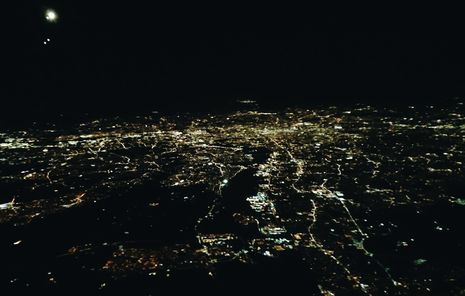From here, light and sacred draughts
Some thoughts on Cambridge, the mind, and its beautiful, brave power to question and create.

One of my favourite images in literature has been that towards the close of ‘The Old Fools’, a poem by Philip Larkin:
Perhaps being old is having lighted rooms/ Inside your head, and people in them, acting.
Our individual thought-worlds are like ‘lighted rooms’, walled chambers wherein the people of our past move about our memories like small, marionetted actors. Our minds, with their undulating movements of thought and reflection - imagining, perceiving and reacting through emotion and affect – can be teased out into a plurality of dimension, and understood in spatial terms. Gaston Bachelard, in the 1950s, wrote of the ‘poetics of space’, hemming together thought and feeling into a sort of ‘reverberation’ that goes on in our minds whenever we are touched by something novel and interesting.
Space in this sense, the sort that is ‘inside your head’, is inward, interior, individuated. Virginia Woolf’s ‘room of one’s own’, for instance, around which swirl ideas of the independence of thought and action; the freedom to enact, and to print upon the page, one’s own thinking and feeling. In the final sentences of an essay on Bede, Marguerite Yourcenar invites us to picture the fleeting, individual human life as, successively, ‘la salle assiégée par la neige et le vent, illuminée, pour un temps, au sein de la triste grisaille de l’hiver’ [the room lashed by snow and wind, illuminated, momentarily, within the cold grisaille of winter], and ‘celui de cerveau, chambre éclairée, feu central, temporairement placé pour chacun de nous au milieu des choses’ [that of the brain, lit room, central fire, temporarily placed for each of us in the middle of things]. What we glimpse of the ‘lighted room’ of another person’s mind reminds us of the transience of individual existence but also and more importantly: awe towards the ‘feu central’, the flickering light of the brain and its beautiful, brave power to think, question and create.
Sometimes, when the day tapers into evening during term-time and we switch on the lights of our rooms, I think of all those minds at work along King’s Parade: solving problems, pausing upon a turn of phrase, or penning an essay, caught up in a voluptuous whirl of thought. The ticking of individual minds that have gathered from all across the country and the world, by car and rail and plane, to a central point for the purposes of the creation, exchange and testing of ideas. It reminds me of the feeling of being lifted above a city on an evening flight, as you peer out of the window and see the convergence of all those lights against the dark.
Thinking of other people’s minds as mysterious ‘lighted rooms’ moreover seems a relevant analogy amidst current social distancing measures, where our homes and households are the fulcrum of our daily activities. Folded up in our individual houses and rooms, and missing our friends, we imagine them to exist in similar states of enclosure. With limitations on communal space and direct connection, these spaces seem private, inscrutable, geographically dispersed.
I came across an article the other day suggesting that ‘We are all Edward Hopper paintings now’ – an analogy that’s perhaps worth pausing upon. Delocalised from Cambridge and its nexus of shared spaces – Sidgwick, the theatres, the libraries, various pubs and clubs - we find ourselves curiously solitary, left to stare out of our individual windows from our ‘lighted rooms’.
The light cast upon these individuals is one grown cold, flattened into shapes, uninviting. Far from the softened touches of Homer’s Dawn, it is lonely, with hard edges. It is the stark, artificial light of the non-LED lightbulb, the light of the sequestered household. And perhaps what is most disorientating: these solitary figures of Hopper seem mirrors of ourselves; we too are staring out, our own windowsills like the frame of the canvas upon the scene before us. Our ‘lighted rooms’ painfully blocked apart, where the very act of seeing, by the painted figures as well as ourselves as onlookers of the artwork, intimates a silent longing for connection.
Dante’s vision of Paradise was one wherein these pinpricks were brought together: twists, threads and interstices of light, held together in woven filigree. The Paradiso seems to be composed in a medium of threads and filaments: the souls he encounters, made of light, are enveloped in their rays ‘like a creature swathed in its own silk’, and he dreams of the night air ‘threaded thick’ with moonlight, the moon herself laced with rainbow webs. He saw the reciprocated gaze of lovers as a thread compounding thoughts and emotions as tiny spiritelli,spirits that pierce the heart and ignite sparks. Light invokes a shared nexus of vision, and in doing so, unifies – the floodlight upon Norma in a cloud of incense brings together the eyes of the audience of the Palais Garnier; the landscapes of Ravilious mesh together geometrical webs of sunlight with those of trees, hills, coastline.
And in this sense, Cambridge is itself a sort of overarching ‘lighted room’ – a hemming together of minds across past, present and future, a constellation-made-filigree of thoughts and ideas. Walking down Pembroke Street, tidying up a footnote in the library, or chatting with friends over scrambled eggs in hall, we are surrounded by what Shelley once called ‘the phantoms of a thousand hours’ – those who in their day, much like us, also plumbed into days and nights of exciting conversation with interesting people.
With this in mind, the usual suspects of what makes otherwise sparky and wonderful people curdle away - fear of the unknown and of others, fruitless self-debasement and the sort of intellectual cowardice that runs beneath a filmy posture of vanity and arrogance – seem petty and stultifying. Far from wasting our time on quibbles, when we see each other again we ought to celebrate and, in our unique ways, stride forward into what is to come, cloaked in what Shakespeare called ‘the main of light’. The light whose intricacies Newton sought to prise apart with his compasses, the light that Wordsworth glimpsed in the Immortality Ode, the light that played upon the desk of Keynes as he pieced together the groundwork of modern economics. Cambridge’s motto, after all, is hinc lucem et pocula sacra. From here, light, and sacred draughts.
 Features / Should I stay or should I go? Cambridge students and alumni reflect on how their memories stay with them15 December 2025
Features / Should I stay or should I go? Cambridge students and alumni reflect on how their memories stay with them15 December 2025 News / Cambridge study finds students learn better with notes than AI13 December 2025
News / Cambridge study finds students learn better with notes than AI13 December 2025 News / Uni Scout and Guide Club affirms trans inclusion 12 December 2025
News / Uni Scout and Guide Club affirms trans inclusion 12 December 2025 Comment / The magic of an eight-week term15 December 2025
Comment / The magic of an eight-week term15 December 2025 News / Cambridge Vet School gets lifeline year to stay accredited28 November 2025
News / Cambridge Vet School gets lifeline year to stay accredited28 November 2025









